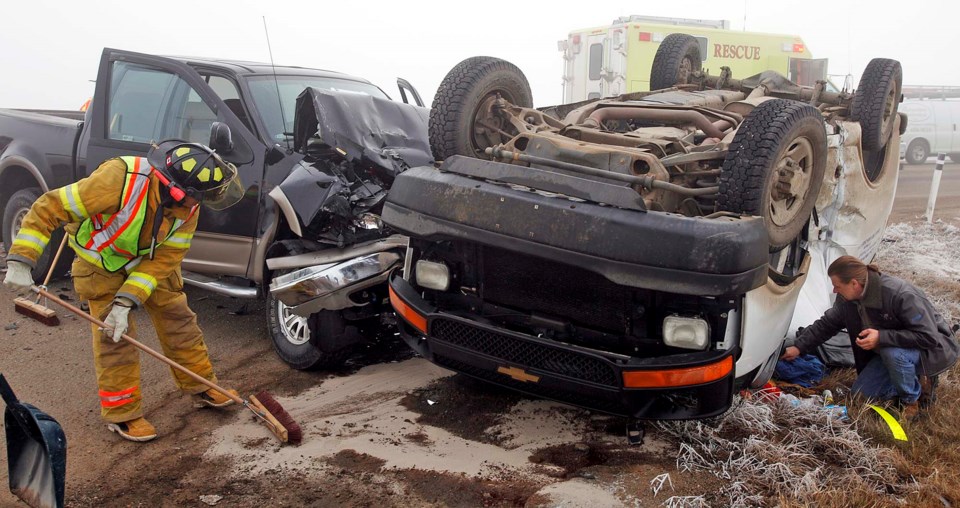New changes to car insurance in Alberta will mean higher costs without guarantees of future savings, say analysts.
Alberta Premier Danielle Smith and Finance Minister Nate Horner unveiled changes to the province’s auto insurance system last Nov. 21.
Car insurance costs in Alberta have surged in recent years, with University of Calgary economist Jack Mintz reporting a 50 per cent jump in premiums in the last decade. That’s sparked concerns about affordability. Insurance companies, meanwhile, have started leaving the province due to high costs.
Alberta’s insurance system offers so little money to injured drivers that they’re essentially forced to sue to get support, Smith said.
“Albertans need a better system that will lower the cost of insurance for drivers while providing the timely supports they need should they get into a collision.”
Higher cap, care-first
The province froze auto insurance rates in 2023 and capped their increases to 3.7 per cent for good drivers this year in response to concerns about affordability.
Under the reforms, Horner said the province will let insurance companies raise rates by 7.5 per cent for good drivers per year starting January 2025 to reflect the rising cost of lawsuits, vehicle repairs, and natural disasters, in hopes that doing so will help them stay financially viable.
“There are companies right now that for every dollar they take in, they’re paying $1.40,” Horner said, with most paying out $1.17 per dollar in.
The reforms will also see the province switch to a care-first/no-fault insurance system by January 2027.
Alberta’s current system all but requires people injured in a car collision to sue to get reasonable compensation. (Without suing, you can get up to $50,000 for medical expenses and $600 a week for two years — not a lot if you, say, lost a limb.)
Under a care-first/no-fault system, a person in a collision would automatically get compensation for their injuries from their insurance company regardless of who was at fault in the collision without having to sue. Manitoba, B.C., and Quebec have similar no-fault systems.
Horner said the province would set insurance benefits based on those provided in Manitoba. While the details were still being worked out, the province projects that benefits should cover up to $6,707 a month in medical expenses and up to $120,000 a year in income replacement for life (or until the person no longer shows signs of improvement), plus other benefits.
Horner said at-fault drivers will still be penalized under this system, as they will pay higher insurance premiums. People will also be allowed to sue drivers if criminal or major traffic offences such as distracted driving are involved in a collision.
Smith said these reforms should save Albertans money on insurance. A 2024 study by the Nous Group commissioned by the province found that a Manitoba-like no-fault car insurance system delivered by private companies would save Albertans about $385 a year in premiums.
Smith said insurance companies would be able to afford the higher benefits proposed under these reforms because of the near-elimination of legal fees, which currently account for about 20 per cent of payouts.
Alberta’s reformed system differs from Manitoba’s in that it will rely on private insurance companies — Manitoba has government-run car insurance. The Nous report found that the average Albertan would save $732 a year on insurance if Alberta brought in public insurance like Manitoba.
Horner said the province was not switching to public insurance because a recent survey found 83 per cent of Albertans wanted to be able to shop around for insurance providers. A public insurer would also take five years and about $3 billion to establish, whereas the province could bring in this new system with its current insurers with two years of work.
Smith said the province has told insurance companies that they will bring in public insurance if they cannot make these reforms work.
Lost jobs, uncertain savings
St. Albert MLA Marie Renaud said the province’s reforms would let insurance companies crank up premiums for two years on the promise of future savings that might not even materialize.
“This is a government that’s saying trust us, it will all be great after the election, and we see no evidence of that.”
Mintz, who published a paper on car insurance reform in Alberta last October, said the province’s new cap on insurance rates would prolong the financial struggles of insurance companies, some of which have left Alberta because they couldn’t make money.
“If you look at the past 10 years, they’ve hardly made any money in Alberta,” he said, with some actually losing money prior to the 2020 pandemic.
Mintz said switching to no-fault insurance should lower insurance premiums over the long haul, but could mean less compensation for the seriously injured than they could get in the courts. Insurance companies could also pocket the savings seen by restricting lawsuits instead of passing them onto customers. He supported the province’s decision to stick with private insurance, arguing that private systems were more competitive and innovative.
The Nous report estimated that the province’s reforms would put up to 1,800 insurance-industry workers out of work, up to 800 of whom would be from legal services.
Mark McCourt, who has practiced injury law through McCourt Law Offices in Edmonton and St. Albert for 30 years, said those losses were equivalent to 10 per cent of Alberta’s lawyers and 90 per cent of its personal injury lawyers.
“If you are an auto accident injury lawyer, you’re out of a job,” he said of the proposed reforms, adding that lawyers like himself would likely have to leave Alberta to find work as a result.
The province’s reforms are set to kick in by January 2027. Visit care-first.alberta.ca for details on the changes.



